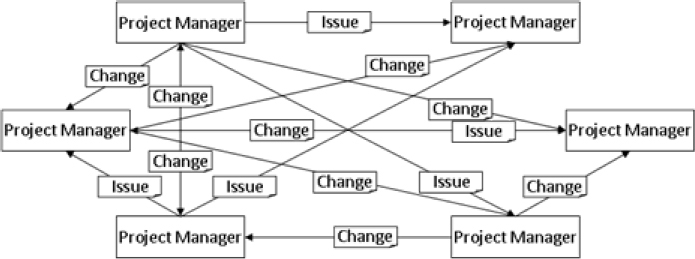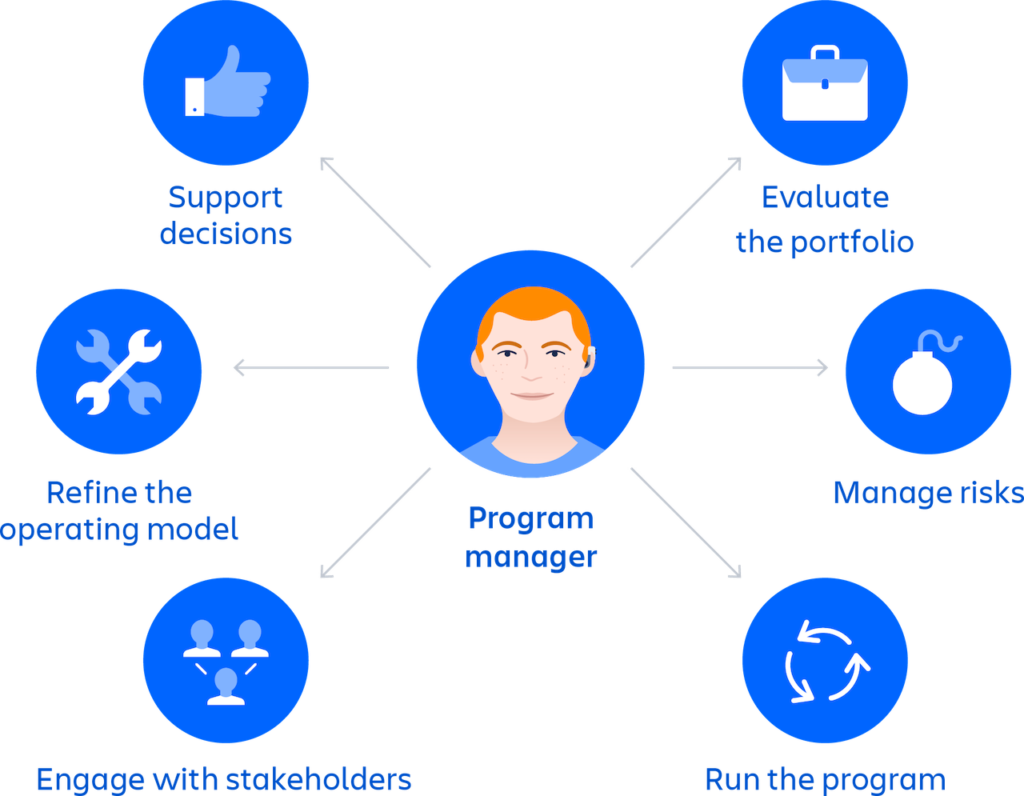The ABC's of IT Program Management

How do you know your organization is ready for IT program management?
You may begin to hear grumblings from staff, such as: ”I asked for that six months ago but I haven’t seen it,” or “I don’t know where my issue is on the list.” The IT team starts using terms like “swamped,” or “firehose,” or “I don’t know what my priority is, what do I work on next?”
These are key red flags signaling that it's time for formal Program Management.
Here, we'll step through multi-project planning and how your organization can put the process in play.
Let's jump in.
What is Information Technology program management?
Program management entails mapping out and implementing a strategic project portfolio to reach an overarching goal. It's a dynamic process that involves systematizing distinct, yet mutually dependent tech projects and tracking interdependencies in change initiatives.
Program-level change initiatives and multi-project complexities can be seen here:

The primary benefits of formal IT program management include:
- Systematic coordination of project dependencies and interdependencies.
- Increased objectivity and visibility into IT resources and functions.
- A unifying and consistent framework across IT projects and initiatives.
- Structured processes for documenting, mitigating, and responding to interdependency risks and challenges.
- Enhanced communication between project managers, contributors, and stakeholders.
The result? Incremental organizational transformation. However, the goals of programs must be attained to sew the seeds of transformation activities. The predominant program goals are:
- Getting a clear, holistic view of all related projects, priorities, and tasks that IT needs to complete to tackle the larger objective.
- Optimizing portfolio performance = eliminating duplicate work and minimizing disruptions, conflicts, and scheduling delays.
IT Program Management vs. IT Project Management
Project management involves managing an individual project within a program, whereas program management involves defining, arranging, and managing related tech projects to achieve a high-level organizational goal.
Project management is a tactical process. It entails overseeing a project's operational components, such as: budgeting, roles, governance, status report, change management, deliverables, and deadlines.
Program management is a strategic process. It's sometimes used interchangeably with "project interdependency management" and "portfolio management." Regardless of semantics, what's key is that a program's objective is the desired business outcome.
| IT Program Management | IT Project Management |
| Strategic | Tactical |
| Plan and manage strategy and implementation | Plan and manage individual project(s) within the program |
| Delegate projects within the portfolio to the appropriate project manager or equivalent. | Orchestrate project operations, dependees, and contributors. |
| Focused on long-term organizational outcome in which there's a relatively larger, more fluid scope. | Focused on attaining the predefined output within the specified project scope, budget, and deadline. |
Program and project management have a synergistic yin-yang interaction. The complementary program-project relationship reinforces the distinct processes and competencies involved in each role.
The IT program manager and project manager are mission-essential positions that work cooperatively to accomplish shared initiatives. The IT program manager also works closely with the CIO (Chief Information Officer) or the person leading your association's digital transformation.
What is Involved in Program Management?

Program managers are responsible for aligning IT strategy with the desired organizational outcome. The program management practices and processes include:
- Framing and arranging a collection of relatively smaller, short-term project initiatives.
- Communicating project objectives to the delegated project manager in terms of its impact on the target organizational outcome, alignment with business objectives, and the projected output.
- Managing, advising, and partnering with stakeholders to discover the context surrounding the overall goal, and then guide project teams accordingly.
- Adapting to changes, managing risk, and evolving the interrelated deliverables and scope as needs change over the course of the program.

Capabilities and Competencies
Optimizing portfolio performance calls for a high level of proficiency in the area of "Interdependency Management" including scenario planning, project interdependency mapping, and performance-based project coordination.
Program managers also need many of the same agile values and capabilities as IT leaders undergoing continuous process improvement. For example, change management is easily the most important function and core competency in technical program management.
Others include IT team structuring and organizational design, risk management, adaptability, strategic communication and collaboration, IT team empowerment, value creation, stakeholder management, and scenario planning.
Tools and Techniques
There are tons of tools, techniques, and frameworks in program management to strategize and execute programs in the standard operating environment. Dependency Structure Matrix or Design Structure Matrix (DSM) is one way to map project dependencies and interdependencies.

Examples include: SWOT analysis, PEST (examining political, economic, social, and technological factors) analysis, RACI (responsible, accountable, consulted, informed) modeling, stakeholder matrix, cause-and-effect diagrams (fishbone diagrams), risk mapping and profiling, decision tree mapping, and spider charting (radar charting of project risks).
To a certain degree, these tools are all crucial in Information Technology/Information Systems (IT/IS) program management.
How to Establish Your Program Plan
Here's how you can develop a mature IT program that furthers change initiatives and incremental performance improvement.
- Set the program objective. It should align with your organizational strategy and the desired outcome.
- Identify all IT projects/tasks/items related to the objective. This requires talking directly with stakeholders and combing through IT logs.
- Take note of interrelated projects and milestones that determine whether you can safely move to the next phase of the program plan. This requires a strong analysis of milestone trends and scenario planning.
- Start to correlate, connect, and map out dependencies and interdependencies. Include all related initiatives here, big and small. Use the mapping tools and techniques we discussed in the previous section.
- Systematize all related projects and deliverables. You'll need to dive into the program management toolkit in this step as well.
- Develop an early warning system to alert you of delayed, postponed, and rescheduled target dates and milestone deliverables.
- Delegate projects and communicate the objectives and impact of each to the assigned project manager.
- Parter with stakeholders throughout the course of the program and coordinate with project managers.
- Adapt the program as needed to accommodate changes.
Is Your Organization Ready for IT Program Management?
Tech departments are wrapped up in multiple projects, day-to-day tasks, and regular last-minute fire drills. In turn, IT leaders and decision-makers are often unable to adequately track value-added IT initiatives and the gaps between IT delivery and business requirements.
The answer to these issues is program management. It establishes a unifying process across several IT/IS projects.
So, is your organization ready? Take our IT Management Assessment to evaluate your need for a formal tech program.



